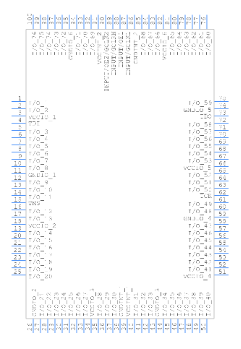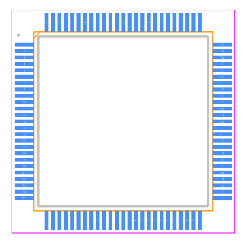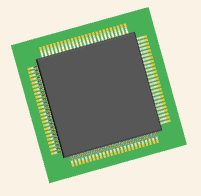EPM7128AETI100-7N CPLDs: Features, Applications and Datasheet
2024-11-13 10:23:57 1066
EPM7128AETI100-7N Description
The EPM7128AETI100-7N is a high-performance, low-power programmable logic device (PLD) from Altera’s MAX 7000 family. It is designed for a wide range of applications requiring flexible logic functions. The device contains 128 macrocells and is implemented in a 100-pin TQFP package. The EPM7128AETI100-7N features an advanced architecture that allows it to handle complex logic functions with lower power consumption compared to traditional FPGA designs, making it ideal for cost-sensitive and space-constrained applications.
EPM7128AETI100-7N Features
128 Macrocells: Provides flexible logic design capabilities for complex logic and control functions.
Low Power Consumption: Optimized for low-power operation, making it suitable for battery-operated or portable applications.
High-Speed Performance: Provides a fast logic speed with propagation delays as low as 7ns.
Programmable I/O: The device features versatile I/O capabilities, allowing the configuration of input, output, and bidirectional pins as needed.
Built-In Programmable Logic Arrays (PLAs): Includes PLAs to simplify design and reduce component count.
Advanced Programmability: Configurable using Altera’s Quartus software tools, enabling fast design implementation and testing.
100-Pin Package: Offered in a 100-pin TQFP package, suitable for designs requiring compact form factors.
Glitch-Free Logic: Built-in support for glitch-free logic operations in applications requiring reliable and stable performance.
EPM7128AETI100-7N Applications
Consumer Electronics: Used in home appliances, entertainment systems, and gaming consoles for customizable logic and control functions.
Industrial Control: Ideal for programmable controllers, sensor interfaces, and automation systems.
Automotive Systems: Suitable for automotive applications requiring control over sensor data processing, communications, and actuator controls.
Communication Equipment: Used in routers, switches, and network devices for data routing and control.
Medical Devices: Enables logic control in diagnostic equipment, patient monitoring systems, and medical instruments.
Embedded Systems: Frequently used in embedded systems for custom logic, signal processing, and interfacing with microcontrollers and other peripherals.
EPM7128AETI100-7N CAD Model
Symbol

Footprint

3D Model


EPM7128AETI100-7N Alternatives
Xilinx XC9572XL-10TQG44C: A competing CPLD from Xilinx, offering similar performance and logic density in a compact package.
Lattice ispLSI 1032E-7L: A low-power CPLD with a similar range of I/O capabilities and a comparable logic density.
Intel MAX 10 10M50DAF484C7G: A newer FPGA from Intel with greater logic capacity and built-in analog-to-digital conversion for mixed-signal applications.
Microchip ATF1508AS-7AU84: Another CPLD with a similar number of macrocells and a low-power design, suitable for similar applications.
Lattice ECP5-5G: A more advanced FPGA solution from Lattice, offering more logic resources, but suited for applications requiring more complex designs.
EPM7128AETI100-7N FAQs
What kind of logic functions can the EPM7128AETI100-7N perform? The EPM7128AETI100-7N can perform a wide range of logic functions such as combinational logic, state machines, memory addressing, and signal routing. It is ideal for applications that require custom logic configurations, including industrial control, embedded systems, and communication equipment.
How can the EPM7128AETI100-7N be programmed? The device can be programmed using Altera’s Quartus software suite, which provides a range of design and simulation tools. Once the design is completed, the device can be programmed through a JTAG interface or other supported methods.
What are the key benefits of using the EPM7128AETI100-7N in embedded designs? The EPM7128AETI100-7N provides embedded designers with a cost-effective, low-power solution for custom logic requirements. It allows for flexible I/O configuration, supports high-speed operation, and can be easily integrated with other components in embedded systems, enabling faster time-to-market and reduced system complexity.
How does the EPM7128AETI100-7N compare to other FPGAs in terms of power consumption? The EPM7128AETI100-7N is optimized for low power consumption compared to larger FPGAs, making it suitable for applications where power efficiency is critical, such as in battery-operated devices and portable electronics.
Can the EPM7128AETI100-7N be used in high-temperature environments? Yes, the EPM7128AETI100-7N is rated for operation within a standard industrial temperature range (-40°C to 100°C), making it suitable for use in a variety of industrial and automotive applications that require operation in harsh temperature conditions.




